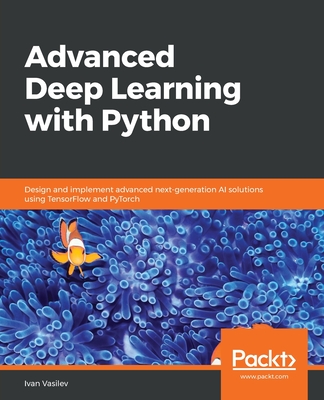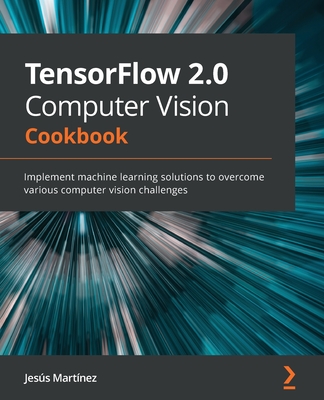Modern Computer Vision with PyTorch - Second Edition: A practical roadmap from deep learning fundamentals to advanced applications and Generative AI
Ayyadevara, V. Kishore, Reddy, Yeshwanth
- 出版商: Packt Publishing
- 出版日期: 2024-06-10
- 售價: $2,350
- 貴賓價: 9.5 折 $2,233
- 語言: 英文
- 頁數: 746
- 裝訂: Quality Paper - also called trade paper
- ISBN: 1803231335
- ISBN-13: 9781803231334
-
相關分類:
DeepLearning、人工智慧、Computer Vision
立即出貨 (庫存 < 3)
買這商品的人也買了...
-
 如何衡量萬事萬物:大數據時代,做好量化決策、分析的有效方法 (How to Measure Anything: Finding the Value of
如何衡量萬事萬物:大數據時代,做好量化決策、分析的有效方法 (How to Measure Anything: Finding the Value of$480$379 -
 了不起的 Markdown
了不起的 Markdown$390$371 -
 大數據資料可視化:Python QT GUI 程式設計 (有些許瑕疵,不影響閱讀)
大數據資料可視化:Python QT GUI 程式設計 (有些許瑕疵,不影響閱讀)$880$748 -
 Feature Engineering and Selection: A Practical Approach for Predictive Models
Feature Engineering and Selection: A Practical Approach for Predictive Models$2,250$2,138 -
 $505知識圖譜實戰
$505知識圖譜實戰 -
 $305知識圖譜:方法、工具與案例
$305知識圖譜:方法、工具與案例
相關主題
商品描述
The definitive computer vision book is back, featuring the latest neural network architectures and an exploration of foundation and diffusion models
Purchase of the print or Kindle book includes a free eBook in PDF format
Key Features
- Understand the inner workings of various neural network architectures and their implementation, including image classification, object detection, segmentation, generative adversarial networks, transformers, and diffusion models
- Build solutions for real-world computer vision problems using PyTorch
- All the code files are available on GitHub and can be run on Google Colab
Book Description
Whether you are a beginner or are looking to progress in your computer vision career, this book guides you through the fundamentals of neural networks (NNs) and PyTorch and how to implement state-of-the-art architectures for real-world tasks.
The second edition of Modern Computer Vision with PyTorch is fully updated to explain and provide practical examples of the latest multimodal models, CLIP, and Stable Diffusion.
You'll discover best practices for working with images, tweaking hyperparameters, and moving models into production. As you progress, you'll implement various use cases for facial keypoint recognition, multi-object detection, segmentation, and human pose detection. This book provides a solid foundation in image generation as you explore different GAN architectures. You'll leverage transformer-based architectures like ViT, TrOCR, BLIP2, and LayoutLM to perform various real-world tasks and build a diffusion model from scratch. Additionally, you'll utilize foundation models' capabilities to perform zero-shot object detection and image segmentation. Finally, you'll learn best practices for deploying a model to production.
By the end of this deep learning book, you'll confidently leverage modern NN architectures to solve real-world computer vision problems.
What you will learn
- Get to grips with various transformer-based architectures for computer vision, CLIP, Segment-Anything, and Stable Diffusion, and test their applications, such as in-painting and pose transfer
- Combine CV with NLP to perform OCR, key-value extraction from document images, visual question-answering, and generative AI tasks
- Implement multi-object detection and segmentation
- Leverage foundation models to perform object detection and segmentation without any training data points
- Learn best practices for moving a model to production
Who this book is for
This book is for beginners to PyTorch and intermediate-level machine learning practitioners who want to learn computer vision techniques using deep learning and PyTorch. It's useful for those just getting started with neural networks, as it will enable readers to learn from real-world use cases accompanied by notebooks on GitHub. Basic knowledge of the Python programming language and ML is all you need to get started with this book. For more experienced computer vision scientists, this book takes you through more advanced models in the latter part of the book.
Table of Contents
- Artificial Neural Network Fundamentals
- PyTorch Fundamentals
- Building a Deep Neural Network with PyTorch
- Introducing Convolutional Neural Networks
- Transfer Learning for Image Classification
- Practical Aspects of Image Classification
- Basics of Object Detection
- Advanced Object Detection
- Image Segmentation
- Applications of Object Detection and Segmentation
- Autoencoders and Image Manipulation
- Image Generation Using GANs
(N.B. Please use the Read Sample option to see further chapters)
商品描述(中文翻譯)
《權威的電腦視覺書籍回來了,涵蓋最新的神經網絡架構以及基礎模型和擴散模型的探索》
購買印刷版或Kindle版書籍可獲得免費的PDF格式電子書
主要特色
- 理解各種神經網絡架構的內部運作及其實現,包括圖像分類、物體檢測、分割、生成對抗網絡、變壓器和擴散模型
- 使用PyTorch構建現實世界的電腦視覺問題解決方案
- 所有代碼文件均可在GitHub上獲得,並可在Google Colab上運行
書籍描述
無論您是初學者還是希望在電腦視覺職業中進步,本書將引導您了解神經網絡(NN)和PyTorch的基本概念,以及如何為現實世界任務實現最先進的架構。
《現代電腦視覺與PyTorch》的第二版已全面更新,解釋並提供最新的多模態模型、CLIP和Stable Diffusion的實用範例。
您將發現處理圖像的最佳實踐、調整超參數和將模型投入生產的技巧。隨著進展,您將實現面部關鍵點識別、多物體檢測、分割和人體姿勢檢測的各種用例。本書為您探索不同的GAN架構提供了堅實的圖像生成基礎。您將利用基於變壓器的架構,如ViT、TrOCR、BLIP2和LayoutLM,執行各種現實世界任務並從零開始構建擴散模型。此外,您將利用基礎模型的能力進行零樣本物體檢測和圖像分割。最後,您將學習將模型投入生產的最佳實踐。
在這本深度學習書籍結束時,您將能夠自信地利用現代NN架構解決現實世界的電腦視覺問題。
您將學到的內容
- 熟悉各種基於變壓器的電腦視覺架構、CLIP、Segment-Anything和Stable Diffusion,並測試其應用,如圖像修補和姿勢轉移
- 將CV與NLP結合,執行OCR、從文檔圖像中提取鍵值、視覺問答和生成AI任務
- 實現多物體檢測和分割
- 利用基礎模型在沒有任何訓練數據點的情況下進行物體檢測和分割
- 學習將模型投入生產的最佳實踐
本書適合對象
本書適合PyTorch初學者和希望使用深度學習和PyTorch學習電腦視覺技術的中級機器學習從業者。對於剛開始接觸神經網絡的人來說,本書將使讀者能夠從現實世界的用例中學習,並附有GitHub上的筆記本。您只需具備Python編程語言和機器學習的基本知識即可開始閱讀本書。對於更有經驗的電腦視覺科學家,本書在後半部分將帶您了解更高級的模型。
目錄
- 人工神經網絡基礎
- PyTorch基礎
- 使用PyTorch構建深度神經網絡
- 介紹卷積神經網絡
- 圖像分類的遷移學習
- 圖像分類的實用方面
- 物體檢測基礎
- 高級物體檢測
- 圖像分割
- 物體檢測和分割的應用
- 自編碼器和圖像操作
- 使用GAN進行圖像生成
(注意:請使用“閱讀範本”選項查看後續章節)











